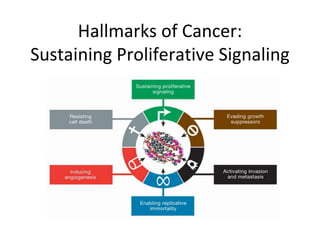
Hallmarks of Cancer - Sustained Proliferative Signaling
- 1. Hallmarks of Cancer: Sustaining Proliferative Signaling
- 2. The Fundamentals of Cancer • The ability of cancer cells to sustain chronic proliferation is fundamental • Allows cancer cells to grow into tumors, metastasize, and invade other regions of the body (Hanahan and Weinberg, 2011)
- 3. Propagation of Normal Cells vs. Cancer Cells
- 4. The Big Question •How do cancer cells acquire the ability to replicate continuously?
- 5. Sustained Proliferative Signaling • Cancer cells maintain constant growth through sustaining proliferative signaling • Deregulation of cell signaling pathways allows cancers cells to upregulate growth signals and downregulate anti- growth signals
- 6. The Stages of Cell Signaling 1. Reception: Binding between a ligand molecule and receptor; highly specific 2. Transduction: conversion of a signal to a form that can bring about a specific response via phosphorylation cascade, protein kinases, and second messengers 3. Response: Regulation of gene expression or cytoplasmic activities
- 7. Stages of Cell Signaling
- 8. Mechanisms of Proliferative Signaling • Normal cells require mitogenic growth signals in order to proliferate • Cancer cells acquire growth signal autonomy in a variety of ways (Hanahan and Weinberg, 2011)
- 9. Production of Growth Signals • Cancer cells produce their own growth signals • Ability to synthesize growth factors and signaling molecules to which they are responsive (Fedi et al., 1997) • Creates positive feedback loop for cell growth • Example: Production of PDGT and TGF-alpha by glioblastomas and sarcomas (Fedi et al., 1997)
- 10. Overexpression of Receptors • Cancer cells over-express receptor proteins, in particular, growth factor receptors • Causes cancer cells to become hyper- responsive to external growth signals (Fedi et al., 1997) • Example: Epidermal GF receptor is up- regulated in stomach, brain, and breast tumors (Slamon et al.,1987)
- 11. Ligand-Independent Signaling • Over-expression of growth factor receptors induces ligand-independent signaling (DiFoire et al., 1987) • No need for signaling molecules to trigger cell division and growth • Same result achieved through structural alterations of receptor proteins • Example: Modified EGF receptor induces non- stop signaling (Fedi et al., 1997)
- 12. Downstream Alterations • Downstream alterations of intracellular circuits can trigger proliferative signaling • SOS-Ras-Raf-MAP Kinase growth pathway • Example: In 25% of tumors, Ras proteins are modified to induce mitogenic signals downstream of the GF receptor (Medema and Bos, 1993)
- 14. Recruitment of Normal Cells • Cancer cells recruit normal cells neighbors to supply growth factors and signals • Cancer cells stimulate normal cells to release growth factors into the tumor microenvironment (Cheng et al., 2008; Bhowmick et al., 2004) • Key role of fibroblasts and endothelial cells • Paracrine signaling vs. endocrine signaling
- 15. The Genetic Basis of Unregulated Growth: Mutation • Genetic mutation leads to cancer • Over-expression of oncogenes, under-expression of tumor suppressor genes • Mutations in oncogenes mimic growth signaling (Hanahan and Weinberg, 2000) • About half of human tumors have mutant Ras oncogenes (Kinzler and Vogelstein, 1996)
- 16. New Research • Somatic mutations activate additional downstream pathways • About 40% of human melanomas contain mutations affecting B-Raf proteins in the MAP- kinase pathway (Davies and Samuels, 2010) • Defects in negative-feedback loops promote proliferative signaling • Mutations in Ras oncogenes compromise GTPase activity, which regulates proliferative signaling (Hanahan and Weinberg, 2011)
- 17. Reference Hanahan, D., & Weinberg, R. A. (2011). Hallmarks of Cancer: The Next Generation. Cell, 144, 646-674. Hanahan, D., & Weinberg, R.A. (2000). The Hallmarks of Cancer. Cell, 100, 57-70